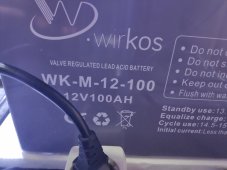Well done with your first system. You did the right thing being conservative to start with, as the chance of doing any damage is very unlikely.
When you see a chart which estimates the state of charge (SOC) of a lead acid battery from its voltage - this is usually based on a
resting voltage, i.e. no load, no charging. Which is of course not particularly helpful as we mostly want to know the SOC while the battery is being used.
Obviously as a battery is discharged it gradually loses voltage.
However when a load is applied to a lead acid battery they also immediately step down in voltage. How much the voltage steps down depends on the size of the load applied and the condition of the battery. Remove the load and the voltage recovers, as you have noted.
Hence, using voltage as a guide to SOC while under load is misleading, and given batteries in service tend to either be under load or being charged, then the voltage isn't more than a very general guide as to what their state of charge is. Of course there are still lower voltage limits we should be wary of not going below even when load is applied.
As Supervstech says, the most convenient way to get a decently accurate picture of the SOC while in use is to have a coulomb meter / shunt which measures the voltage and the charge flowing from or into the battery.
Given the recovered "resting" voltage was 12.5+ V, then I'd say you ceased your test well before they had reached 50% SOC.
It's not a bad thing to be conservative about how much you discharge lead acid. The deeper you discharge them, the fewer cycles you can expect to get from them over their useful life. If the battery is going to be performing only occasional discharges because it's for outage backup, then a deeper discharge is fine as they might only be required to do this a few dozen times. But they need to be recharged very soon afterwards.
A 12 V battery with 100 Ah of capacity has a nominal energy capacity of 12 V x 100 Ah = 1200 Wh or 1.2 kWh
However you should consider only a proportion of that capacity as being effectively useable. Discharging the full 1200 Wh would shorten its useable life significantly.
So if you decide you do not wish to discharge the battery lower than 50% state of charge (SOC) then you can discharge no more than half of that 1200 Wh, i.e. 600 Wh (assuming it is fully charged to begin with).
On the AC load side you have a load of 230 watts. The inverter itself will also be consuming energy and there are losses involved when converting DC to AC power. How much those losses are varies but let's assume you need to add another 15% to allow for that (it might be less, or more, it's just to illustrate the example).
So let's call the load 230 W + 15% for the losses, which is about 265 W in total.
600 Wh / 265 W = about 2.25 hours, 2 hours 15 minutes.
Anyway, the above is just an example to illustrate how to think about how long you can reasonable power loads. It also assumes of course that your measurement of load is accurate too (it can be measured with a plug in power meter).
Battery University is a good reference to learn about many things to do with batteries, and they have chapter on lead acid:
Battery University™ is a free educational website offering hands-on battery information.

batteryuniversity.com
Good luck with it.





